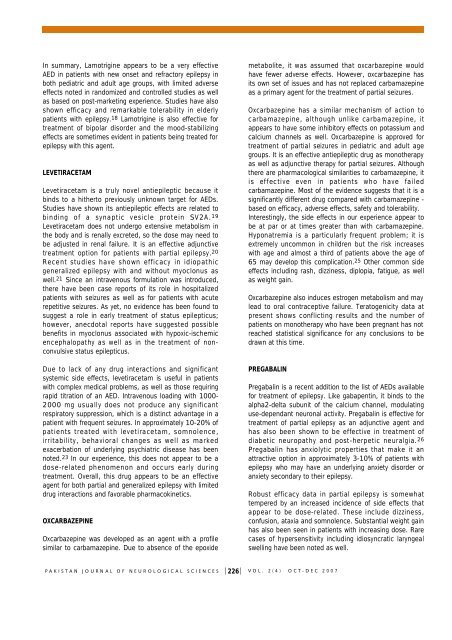antiepileptic drug therapy: role of newer agents - Pakistan Journal Of ...
antiepileptic drug therapy: role of newer agents - Pakistan Journal Of ...
antiepileptic drug therapy: role of newer agents - Pakistan Journal Of ...
You also want an ePaper? Increase the reach of your titles
YUMPU automatically turns print PDFs into web optimized ePapers that Google loves.
In summary, Lamotrigine appears to be a very effective<br />
AED in patients with new onset and refractory epilepsy in<br />
both pediatric and adult age groups, with limited adverse<br />
effects noted in randomized and controlled studies as well<br />
as based on post-marketing experience. Studies have also<br />
shown efficacy and remarkable tolerability in elderly<br />
patients with epilepsy. 1 8 Lamotrigine is also effective for<br />
treatment <strong>of</strong> bipolar disorder and the mood-stabilizing<br />
effects are sometimes evident in patients being treated for<br />
epilepsy with this agent.<br />
LEVETIRACETAM<br />
Levetiracetam is a truly novel <strong>antiepileptic</strong> because it<br />
binds to a hitherto previously unknown target for AEDs.<br />
Studies have shown its <strong>antiepileptic</strong> effects are related to<br />
binding <strong>of</strong> a synaptic vesicle protein SV2A. 1 9<br />
Levetiracetam does not undergo extensive metabolism in<br />
the body and is renally excreted, so the dose may need to<br />
be adjusted in renal failure. It is an effective adjunctive<br />
treatment option for patients with partial epilepsy. 2 0<br />
Recent studies have shown efficacy in idiopathic<br />
generalized epilepsy with and without myoclonus as<br />
well. 21 Since an intravenous formulation was introduced,<br />
there have been case reports <strong>of</strong> its <strong>role</strong> in hospitalized<br />
patients with seizures as well as for patients with acute<br />
repetitive seizures. As yet, no evidence has been found to<br />
suggest a <strong>role</strong> in early treatment <strong>of</strong> status epilepticus;<br />
however, anecdotal reports have suggested possible<br />
benefits in myoclonus associated with hypoxic-ischemic<br />
encephalopathy as well as in the treatment <strong>of</strong> nonconvulsive<br />
status epilepticus.<br />
Due to lack <strong>of</strong> any <strong>drug</strong> interactions and significant<br />
systemic side effects, levetiracetam is useful in patients<br />
with complex medical problems, as well as those requiring<br />
rapid titration <strong>of</strong> an AED. Intravenous loading with 1000-<br />
2000 mg usually does not produce any significant<br />
respiratory suppression, which is a distinct advantage in a<br />
patient with frequent seizures. In approximately 10-20% <strong>of</strong><br />
patients treated with levetiracetam, somnolence,<br />
irritability, behavioral changes as well as marked<br />
exacerbation <strong>of</strong> underlying psychiatric disease has been<br />
noted. 23 In our experience, this does not appear to be a<br />
dose-related phenomenon and occurs early during<br />
treatment. Overall, this <strong>drug</strong> appears to be an effective<br />
agent for both partial and generalized epilepsy with limited<br />
<strong>drug</strong> interactions and favorable pharmacokinetics.<br />
OXCARBAZEPINE<br />
Oxcarbazepine was developed as an agent with a pr<strong>of</strong>ile<br />
similar to carbamazepine. Due to absence <strong>of</strong> the epoxide<br />
P A K I S T A N J O U R N A L O F N E U R O L O G I C A L S C I E N C E S 226<br />
metabolite, it was assumed that oxcarbazepine would<br />
have fewer adverse effects. However, oxcarbazepine has<br />
its own set <strong>of</strong> issues and has not replaced carbamazepine<br />
as a primary agent for the treatment <strong>of</strong> partial seizures.<br />
Oxcarbazepine has a similar mechanism <strong>of</strong> action to<br />
carbamazepine, although unlike carbamazepine, it<br />
appears to have some inhibitory effects on potassium and<br />
calcium channels as well. Oxcarbazepine is approved for<br />
treatment <strong>of</strong> partial seizures in pediatric and adult age<br />
groups. It is an effective <strong>antiepileptic</strong> <strong>drug</strong> as mono<strong>therapy</strong><br />
as well as adjunctive <strong>therapy</strong> for partial seizures. Although<br />
there are pharmacological similarities to carbamazepine, it<br />
is effective even in patients who have failed<br />
carbamazepine. Most <strong>of</strong> the evidence suggests that it is a<br />
significantly different <strong>drug</strong> compared with carbamazepine -<br />
based on efficacy, adverse effects, safety and tolerability.<br />
Interestingly, the side effects in our experience appear to<br />
be at par or at times greater than with carbamazepine.<br />
Hyponatremia is a particularly frequent problem; it is<br />
extremely uncommon in children but the risk increases<br />
with age and almost a third <strong>of</strong> patients above the age <strong>of</strong><br />
65 may develop this complication. 25 Other common side<br />
effects including rash, dizziness, diplopia, fatigue, as well<br />
as weight gain.<br />
Oxcarbazepine also induces estrogen metabolism and may<br />
lead to oral contraceptive failure. Teratogenicity data at<br />
present shows conflicting results and the number <strong>of</strong><br />
patients on mono<strong>therapy</strong> who have been pregnant has not<br />
reached statistical significance for any conclusions to be<br />
drawn at this time.<br />
PREGABALIN<br />
Pregabalin is a recent addition to the list <strong>of</strong> AEDs available<br />
for treatment <strong>of</strong> epilepsy. Like gabapentin, it binds to the<br />
alpha2-delta subunit <strong>of</strong> the calcium channel, modulating<br />
use-dependant neuronal activity. Pregabalin is effective for<br />
treatment <strong>of</strong> partial epilepsy as an adjunctive agent and<br />
has also been shown to be effective in treatment <strong>of</strong><br />
diabetic neuropathy and post-herpetic neuralgia. 2 6<br />
Pregabalin has anxiolytic properties that make it an<br />
attractive option in approximately 3-10% <strong>of</strong> patients with<br />
epilepsy who may have an underlying anxiety disorder or<br />
anxiety secondary to their epilepsy.<br />
Robust efficacy data in partial epilepsy is somewhat<br />
tempered by an increased incidence <strong>of</strong> side effects that<br />
appear to be dose-related. These include dizziness,<br />
confusion, ataxia and somnolence. Substantial weight gain<br />
has also been seen in patients with increasing dose. Rare<br />
cases <strong>of</strong> hypersensitivity including idiosyncratic laryngeal<br />
swelling have been noted as well.<br />
V O L . 2 ( 4 ) O C T - D E C 2 0 0 7



